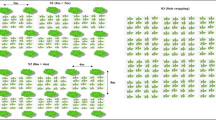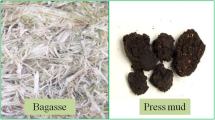Abstract
Maintaining and building up of soil organic carbon (SOC) is very critical for sustaining soil health and crop productivity. Declining SOC is a major concern in semi-arid regions and can be addressed by alteration in the establishment method, involving reduced tillage, bed planting and residue management. For standardizing these crop establishment methods, a field experiment was conducted at Directorate of Rapeseed-Mustard Research, Bharatpur, India from 2009–10 to 2012–13. The effect of conventional tillage (CT), reduced tillage, zero tillage (ZT), and permanent furrow irrigated raised beds (FIRB) on carbon sequestration potential (CSP), sustainability and productivity of Indian mustard under five mustard-based cropping systems, viz, fallow-mustard, green manure-mustard, brown manure-mustard, cluster bean-mustard, and pearl millet-mustard was studied. The experiment was conducted in split-plot design with three replications. The variable tillage practices under different cropping systems significantly affected the soil physical properties and organic carbon dynamics, besides improving mustard productivity and sustainability. An increase of 50 and 16.1 %, respectively was recorded in SOC and infiltration rate under ZT over CT. Likewise, 1.4 and 8.4 folds increase was recorded in mass of soil organic carbon and CSP, respectively in ZT over CT. The bulk density was reduced by 37.3 % in ZT over CT. The highest seed yield was obtained under FIRB (2765 kg ha−1, 23.6 % higher over CT), followed by ZT (2533 kg ha−1, 17.5 % higher over CT). The highest growth, yield, sustainability indices and improved bulk density, infiltration rate, SOC and CSP were recorded under green manure-mustard system followed by brown manure-mustard system.




Similar content being viewed by others
References
Lal R (2004) Soil carbon sequestration impacts on global climate change and food security. Science 304:1623–1627
Shekhawat K, Rathore SS, Premi OP, Kandpal BK, Chauhan JS (2012) Advances in agronomic management of Indian Mustard (Brassica juncea (L.) Czernj. Cosson): an overview. Int J Agron 2012:1–14
Kumar A (2012) Production barriers and technological options for sustainable production of rapeseed-mustard in India. J Oilseed Brassica 3(2):67–77
Wang XB, Cai DX, Hoogmoed WB, Oenema O, Perdok UD (2007) Developments in conservation tillage in rainfed regions of North China. Soil Till Res 93:239–250
Simmons BL, Coleman DC (2008) Microbial community response to transition from conventional to conservation tillage in cotton fields. Appl Soil Ecol 40:518–528
Helgason BL, Walley FL, Germida JJ (2009) Fungal and bacterial abundance in long-term no-till and intensive-till soils of the northern great plains. Soil Sci Soc Am J 73:120–127
Kramer AW, Doane TA, Horwath WR, Van Kessel C (2002) Combining fertilizer and organic inputs to synchronize N supply in alternative cropping systems in California. Agric Ecosyst Environ 91:233–243
Lichter K, Govaerts B, Six J, Sayre KD, Deckers J, Dendooven L (2008) Aggregation and C and N contents of soil organic matter fractions in a permanent raised-bed planting system in the Highlands of Central Mexico. Plant Soil 305:237–252
Fahong W, Xuqing W, Sayre K (2004) Comparison of conventional, flood irrigated, flat planting with furrow irrigated, raised bed planting for winter wheat in China. Field Crops Res 87:35–42
Gangwar KS, Singh KK, Sharma SK, Tomar OK (2006) Alternative tillage and crop residue management in wheat after rice in sandy loam soils of Indo-gangetic Plains. Soil Till Res 88(1–2):242–252
Fabrizzi KP, Gorcia FO, Costa JL, Picone LI (2005) Soil water dynamics, physical properties and corn and wheat responses to minimum and no-tillge systems in south-eastern Pampas of Argentina. Soil Till Res 81:57–69
Thierfelder C, Wall Patrick C (2009) Effects of conservation agriculture techniques on infiltration and soil water content in Zambia and Zimbabwe. Soil Till Res 105(2):217–227
Prasad R, Shivay YS, Kumar D and Sharma SN (2006) Learning by doing exercises in soil fertility (a practical manual for soil fertility). Division of Agronomy, Indian Agricultural Research Institute, New Delhi, 68 p
Bhattacharyya R, Pandey SC, Chandra S, Kundu S, Supradip S, Mina BL, Shrivastava AK, Gupta HS (2010) Fertilization effects on yield sustainability and soil properties under irrigated wheat–soybean rotation of an Indian Himalayan upper valley. Nutr Cycl Agroecosyst 86:255–268
Singh RP, Das SK, Rao UMB, Reddy MN(1990) Towards sustainable Dryland agricultural practices. Bulletin. Central Research Institute for Dryland Agriculture, Hyderabad, pp5–9
Rautaray SK, Dash PC, Sinhabalu DP (2005) Increasing farm income through rice (Oryza sativa)-fish based integrated farming system in rainfed lowlands of Assam. Indian J Agric Sci 75(2):79–82
Logsdon SD, Karlen DL (2004) Bulk density as a soil quality indicator during conversion to no-tillage. Soil Till Res 78:143–149
Roscoe R, Buurman P (2003) Tillage effects on soil organic matter in density fractions of a Cerrado Oxisol. Soil Till Res 104(2):160–165
Hammad EA, Davelbeit MI (2001) Effect of tillage and field conditions on soil physical properties, cand and sugar yield in vertisols of Kenana sugar estate, Sudan. Soil Till Res 62:101–109
Olaoye JO (2002) Influence of tillage on crop residue cover soil properties and yield components of cowpea in derived savanna ectone of Nigeria. Soil Till Res 64:179–189
Chaudhry MR, Malik AA, Sidhu M (2004) Mulching impact on moisture conservation-soil properties and plant growth. Pak J Water Res 8(2):1–8
Osunbitan JA, Oyedele DJ, Adekalu KO (2004) Tillage effects on bulky density, hydraulic conductivity and strength of a loamy sand soil in southwestern Nigeria. Soil Till Res 82:57–64
Agbede TM (2008) Nutrient availability and cocoyam yield under different tillage practices. Soil Till Res 99(1):49–57
Federico GM, Taboada Miguel A (2006) Soil physical properties and Soybean (Glycine max, Merrill) root abundance in conventionally- and zero-tilled soils in the humid Pampas of Argentina. Soil Till Res 86(2):152–162
Ali A, Ayuba SA, Ojeniyi SO (2006) Effect of tillage and fertilizer on soil chemical properties, leaf nutrient contents and yield of soyabean in the guinea savanna zone of Nigeria. Niger J Soil Sci 16:126–130
Agbede TM, Ojeniyi SO (2009) Tillage and poultry manure effects on soil fertility and sorghum yield in southwestern Nigeria. Soil Till Res 104:74–81
Jenny H (1941) Factors of soil formation. McGraw-Hill, New York
Schlesinger WH (1977) Carbon balance in terrestrial detritus. Ann Rev Ecol Syst 8:51–81
Kumar A, Shukla A, Singh RP (1995) Effect of preceeding kharif crop on the performance of Indian rape. In: Proceedings of national symposium on agriculture in relation to environment. Indian Society of Agricultural Sciences, Jan 16–18, Indian Agricultural Research Institute, New Delhi
Kasap A (2001) Effects of the conventional and direct seeding on soil properties, operational time, consumption and yield. In: Proceedings of 20th national congress on agricultural mechanization, Sanlýurfa, Turkey, pp 91–96
Lukman NM, Lal R (2008) Mulching effects on selected soil physical properties. Soil Till Res 98(1):106–111
Shankar G, Verma LP, Singh R (2002) Effect of integrated nutrient management on field and quality of Indian mustard (Brassica juncea) and properties of soil. Ind J Agric Sci 72:551–552
Ghosh PK, Dyal D, Mandal KG, Wanjari RH, Hati KM (2003) Optimization of fertilizer schedules in fallow and groundnut based cropping systems and an assessment of system sustainability. Field Crops Res 80:83–98
Sinsinwar BS, Premi OP, Kumar A (2005) Productivity and economics of different Indian Mustard, [Brassica juncea (L.) Czern & Coss] based cropping systems under irrigated conditions. J Oilseeds Res 22 (1):40–41
Aulakh MS, Pasricha NS (1997) Role of balanced fertilization in oilseed based cropping system. Fertil News 42:101–111
Bhindhu PS, Gaikawad ST (1998) Sustainability yield index of soybean-wheat cropping system as influenced by landform and soil site characteristics. J Indian Soc Soil Sci 46:86–89
Lopez MV, Moret D, Gracia R, Arrue JL (2003) Tillage effects on barley residue cover during follow in semiarid Aragon. Soil Till Res 72:53–64
Hao XH, Liu SL, Wu JS, Hu RG, Tong CL, Su YY (2008) Effect of long-term application of inorganic fertilizer and organic amendments on soil organic matter and microbial biomass in three subtropical paddy soils. Nutr Cycl Agroecosyst 81:17–24
Makino A, Sakashita H, Hidema J, Mae T, Ojima K, Osmond B (1992) Distinctive responses of ribulose-1,5-bisphosphate carboxylase & carbonic anhydrase in wheat leaves to nitrogen nutrition and their possible relationships to CO2 transfer resistance. Plant Physiol 100:1737–1743
Hammer GL, Broad IJ (2003) Genotype and environment effects on dynamics of harvest index during grain filling in sorghum. Agron J 95:199–206
Fischer RA (1985) Number of kernels in wheat crops and the influence of solar radiation and temperature. J Agric Sci Camb 105:447–461
Kiniry JR, Xie Y, Gerik TJ (2002) Similarity of maize seed number responses for a diverse set of sites. Agronomie 22:265–272
Williams JR, Jones CA, Kiniry JR, Spanel DA (1989) The EPIC crop growth model. Trans ASAE 32:497–511
Dunphy EJ, Hanway JJ, Green DE (1979) Soybean yields in relation to days between specific development stages. Agron J 71:917–920
Fakir MSA, Umaharan P, McDavid CR (1998) A modified method for estimating abscission in pigeonpea. Trop Agric (Trinidad) 75(3):393–395
Tayo TO, Morgan DG (1979) Factors affecting flower and pod development in oil-seed rape (Brassica napus L.). J Agric Sci Camb 92:363–373
Khatun M (2004) Study of canopy structure and flower production in mustard. M.Sc. Thesis, Dept. Crop Bot., Bangladesh Agric. Univ., Mymensingh, pp 9–13 (submitted)
Acknowledgments
The authors express gratitude to Indian Council of Agricultural Research (ICAR) and to the Director, ICAR-Directorate of Rapeseed-Mustard Research (DRMR) Bhartpur, Rajasthan for providing necessary facilities. The authors are also thankful to the anonymous reviewers for much help in improving this manuscript.
Author information
Authors and Affiliations
Corresponding author
Ethics declarations
Conflict of interest
The authors declare that they have no conflict of interest.
Rights and permissions
About this article
Cite this article
Shekhawat, K., Rathore, S.S., Kandpal, B.K. et al. Enhancing Carbon Sequestration Potential, Productivity and Sustainability of Mustard Under Conservation Agriculture in Semi-arid Regions of India. Proc. Natl. Acad. Sci., India, Sect. B Biol. Sci. 88, 199–208 (2018). https://doi.org/10.1007/s40011-016-0747-6
Received:
Revised:
Accepted:
Published:
Issue Date:
DOI: https://doi.org/10.1007/s40011-016-0747-6




